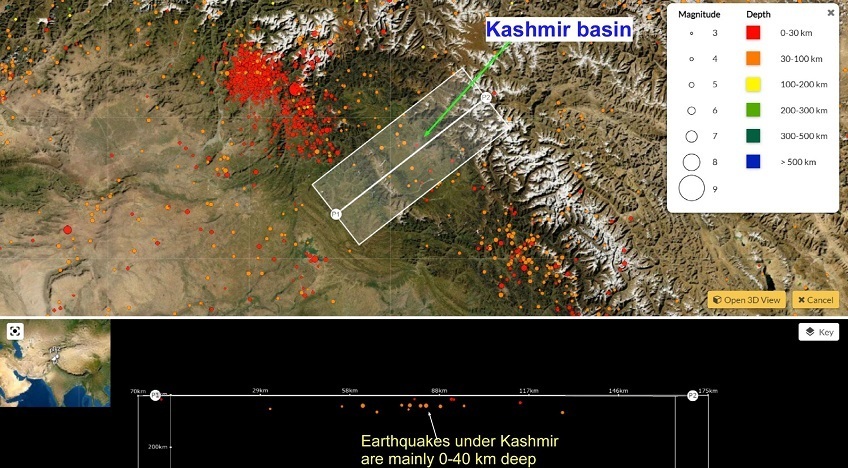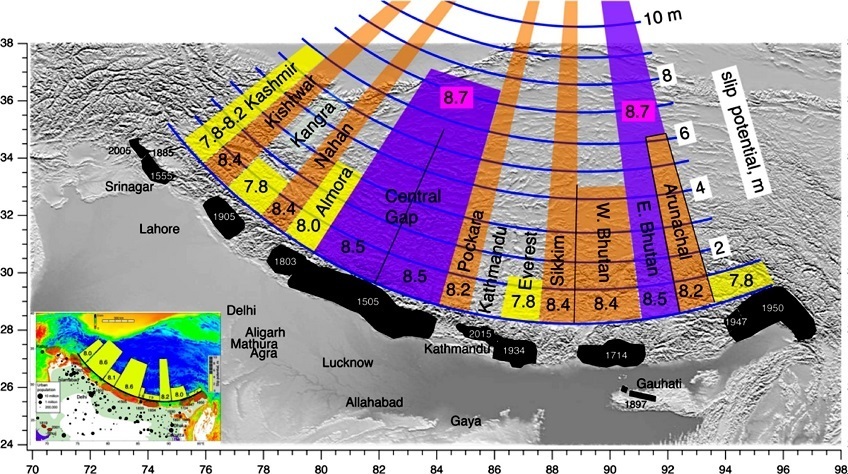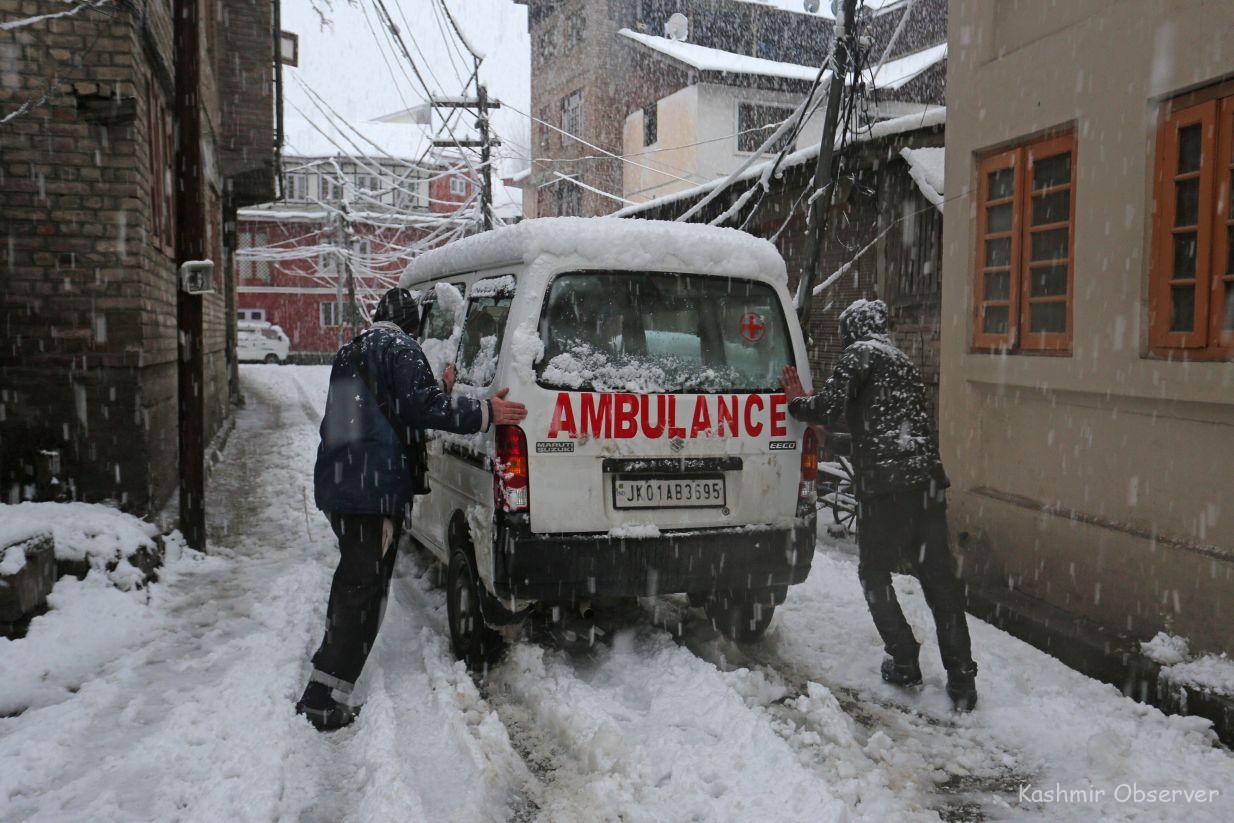
Srinagar: In the past 30 days, Kashmir has experienced around 17 tremors—five of magnitude 4.0 or above, ten between 3.0 and 4.0, and two between 2.0 and 3.0.
These recurrent rattles have coerced seismologists into believing that Kashmir should brace up to face a major earthquake in the future.
“I would say that tremors in Kashmir are the warning signal for us to worry about the incoming of a significant earthquake and prepare the ground to deal with it,” said Dr. Afroz Ahmed Shah, an Earth Sciences expert.
Since Kashmir falls in Seismic zone 5, Dr.Afroz says that one of the most critical components of the preparation is building earthquake-resistant structures.
“We should create a culture first where earthquake education should be at the core of our daily routine because we live on faults and know what that means,” said Dr Shah who teaches Physical & Geological Sciences at the University of Brunei Darussalam.
“The faults can get activated anytime, so please start working on it before it is too late.”
An old hand at understanding the region’s shaky ground Dr Shah in an interview with the Kashmir Observer talked about the reasons behind frequent tremors and what it means for Kashmir.
Why’re we suddenly experiencing so many earthquakes in Kashmir?
Earthquakes in Kashmir are not a surprise and are expected as we live on top of active faults. However, to exactly know the whereabouts of the recent earthquakes, we have to first map and understand the depth of faulting.
I’ve done that by looking at the vertical distribution of earthquakes under Kashmir in the following figure.

It seems that the earthquakes have originated at shallow depths, which suggests rupturing of internal faults within the Kashmir basin, like the Kashmir Basin fault.
The coloured dots are earthquake events, which have dominantly originated between 0-40km depth under the Kashmir basin. The white rectangular area shows the cross-section through the earthquake events to show their vertical positions and depth.
It seems we are on a routine of how active deformation is manifested in a tectonically active area.
Has naturally occurring earthquake activity been increasing at a worrisome rate in Kashmir?
The figure above covers earthquake events from 1980 to 2022, and if we use this as a base, it is safe to argue that earthquakes are continuously occurring in this region, and I don’t see a drastic change.
The data show that earthquakes are a normal consequence of the ongoing deformation in the Kashmir region.
But we haven’t had any high magnitude earthquakes in a long time. Does this mean that the pressure is building up for a big one?
Yes, indeed, the large magnitude earthquake has not occurred in the region for some time. The following figure from Roger Bilham suggests that the region could host a large magnitude earthquake in the future.

The black patches have witnessed significant earthquakes in the past, and gaps are potential areas that may rupture in the future. Kashmir has a record of earthquakes in 1555 and 1885. Now we are within the interseismic cycle, which means the stress is stored within rocks as strain, which can rupture the fault system anytime.
While we are not sure when, but we know it will happen, and we don’t wish to see what happened in Muzaffarabad during the 2005 earthquake. We lost more than 85,000 people and property worth billions.
Therefore, we must work on the preparations for the worst possibility. We cannot stop faults from slipping; what we could do is live with earthquake hazards in our backyard. Get ready for any eventuality.
Do we lack a proper mechanism in Kashmir that can help us to know about the earthquake beforehand?
Predicting an earthquake is not possible because science has not reached there yet. However, forecasting is routinely done, and that knowledge suggests Kashmir could see a major earthquake in the future.
Therefore, we have to help people build a society that is ready to live with earthquake hazards.
I am not aware of any locally produced seismic data recorded by the scientific institutes in the Kashmir region. Usually, such capabilities should be within the institutes that run courses and research on Earth Sciences.
Therefore, we need to have our seismographic network, which could measure the ground shaking locally.
What can we deduce out of these regular tremors?
The cause of active faulting in Kashmir is related to the ongoing lithospheric plate convergence between India and Eurasia, which has formed the mighty Himalayas during the collision journey, and the Kashmir basin in the recent past.
Therefore, earthquake events are expected in the region because they are needed to release the buildup strain within the rocks.
We need to map the earthquake hazards in detail, train people on how to live with faults, and start work on the ground on what one must do to minimize the potential damage during earthquakes.
I would say that earthquakes in Kashmir are the warning signal for us to worry about the incoming of a significant earthquake and prepare the ground to deal with it.

Since we know that Kashmir falls in seismic zone 5, what precautions can people take to minimise the losses?
One of the most critical components of that preparation is building earthquake-resistant structures. We should create a culture first where earthquake education should be at the core of our daily routine because we live on faults and know what that means. The faults can get activated anytime, so please start working on it before it is too late.
We all must learn from the ugly memories of the 2005 earthquake in Muzaffarabad Kashmir. No one would like to see such a situation unfolding in this part of Kashmir.
Therefore, let us work now and build Kashmir from the ruins of the past to the glory of the future; it can be possible if we follow the three-step approach:
First: Extensive work on building earth sciences education culture in Jammu and Kashmir region with a focus on hazards. It should be done from the primary level so that our children know how the planet Earth functions and why earthquakes, floods and landslides occur. It will strengthen their foundations, and they could not be easily dragged and immersed into an ocean of distractions and confusions based on un-scientific discourse that routinely surfaces on social media, the internet etc.
Second: The need to develop Kashmir as the hub of high-quality scientific research on Earth sciences will directly confront the un-scientific culture that is unfortunately prevalent in our societies. We know that education is the key to unlocking the universe’s secrets, and those who remain away or are isolated from the light of wisdom are easily tamed into believing the unscientific discourse in the market. So, it is our responsibility to build that culture where scientific insight becomes our weapon to unlock the questions that have remained unanswered about the planet Earth. It includes hazards, climate change, global warming etc.
Third: The earthquake scientists, engineers, and other responsible civil society members must engage with the local administration and frame a policy document that will highlight the science of earthquakes and what to do to avoid future challenges related to earthquake events in the region. The administration should produce a formal document with information and guidance on building codes. These codes are basically instructions on designing, constructing, and altering buildings in a region that is prone to earthquake hazards. It should be implemented immediately. We are already too late for this, and it is endangering the lives of millions.
As an expert what do you suggest?
I have suggested in the past, and I am doing it again, that Jammu and Kashmir needs to establish a high-quality research institution that will help us produce primary data on the science of earthquakes, landslides, floods, etc. It should professionally train, recruit, and engage locals to enhance the research capability of the region and make it the top institute in the world.
We have a massive army of young students ready to make an impact, but they have nowhere to work in Kashmir, where it is highly needed.
Follow this link to join our WhatsApp group: Join Now
Be Part of Quality Journalism |
Quality journalism takes a lot of time, money and hard work to produce and despite all the hardships we still do it. Our reporters and editors are working overtime in Kashmir and beyond to cover what you care about, break big stories, and expose injustices that can change lives. Today more people are reading Kashmir Observer than ever, but only a handful are paying while advertising revenues are falling fast. |
| ACT NOW |
| MONTHLY | Rs 100 | |
| YEARLY | Rs 1000 | |
| LIFETIME | Rs 10000 | |










